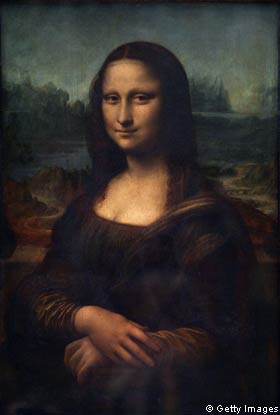Filmmaker Caroline Cocciardi, whose credits include the documentary Mona Lisa Revealed: Secrets of the Painting (2009), claims to have uncovered within the folds of “Mona Lisa”’s dress the answer to a mathematical mystery. After 20 years of research, Cocciardi says she has found evidence that Leonardo da Vinci may have made geometry history by completing one of his long-term obsessions: squaring the circle (creating a square and circle of equal area.) The result lies in a complex embroidered knot found along the neckline of the dress, she says.
Previously Da Vinci was thought to have come closest to completing this long-unsolvable problem in 1504. Jacques Franck, a Da Vinci scholar and consultant to the Louvre, explains: “In the Codex Atlanticus [Da Vinci’s writings 1478-1519] he says that he has completed a treatise on different ways of squaring circles. According to a text from his Madrid II manuscript, Leonardo’s ‘solution’ was reached on November 30 1504.”
Work on the “Mona Lisa” began in 1503 and Da Vinci had the painting in his possession when he died in 1519. Cocciardi became curious about the dress after reading reports that the style was out of fashion in 1503, and not typically used in portraits. She began looking at the knots Da Vinci painted in his portraits and drew in his manuscripts – a relatively unexplored area.
High quality global journalism requires investment. Please share this article with others using the link below, do not cut & paste the article.
She consulted with Renaissance fashion expert Carole Collier Frick, professor of history at Southern Illinois University, the Parisian photographer and engineer Pascal Cotte, and the French Centre for Research and Restoration of the Museums of France.
Cocciardi and Cotte collaborated on the travelling exhibition Da Vinci the Genius, which made headlines in 2007 when Cotte’s high-definition photograph of the “Mona Lisa” revealed that she had eyelashes and eyebrows. He also found a layer of lace over the dress that was no longer visible to the naked eye.
Cotte’s work allowed Cocciardi to take a closer look at the dress. She discovered a “sophisticated octagonal, interlocking pattern on the “Mona Lisa”’s garment at the neckline” – not a typical design for the period.
“For years I thought the pattern was made up of interlocking circles and Turk head knots,” she says. “But under closer inspection something very different emerged that followed no other pattern found in fashion.” She says it was a solution to the squaring of the circle within this “elaborate geometric pattern” – a Da Vinci code of sorts.
Franck says: “It is true that Leonardo used to introduce mathematical underlying meanings into his paintings. He would not have painted the ‘squared circle’ patterns before late November 1504, a date that corresponds to that of the making of the portrait.”
Other experts have different views. UCLA professor Joanna Woods-Marsden believes the significance of the dress lies in the subject’s state of relative “déshabillé. Perhaps she is dressed in timeless biblical garb that was supposed to evoke the antique. However, only before going to bed did a married woman appear with her hair down, and with that enigmatic smile on her mouth.”
By contrast, says Martin Kemp, emeritus research professor in art history at Oxford University, believes, “The dress is classy restrained elegance. Lisa Gherardini’s husband was a silk merchant, and this is a translucent silk over-layer over her dress, gathered at the knot.”
And the geometry aspect? “Leonardo spent a lot of time trying to square the circle,” says Kemp. “Twice he thought he had done it but he never got to the point where he could totally fix it, because it can’t be done.”
Whether Cocciardi’s theory will advance Leonardo studies or go down as another great guess remains to be seen, although Cocciardi says several of the “Da Vincis” – as she calls the elite group of mostly male scholars devoted to Leonardo – have been inquiring about her knot file. “If he did a knot, I have it,” she says.



Tidak ada komentar:
Posting Komentar